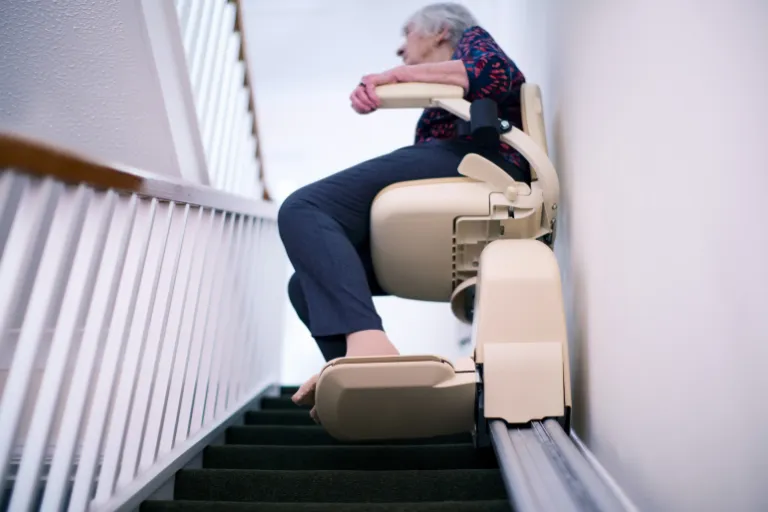Wichtige Punkte
- Elektrische Sessellifte tragen dazu bei, das Sturzrisiko zu verringern und den Treppenzugang für ältere Erwachsene mit eingeschränkter Mobilität wiederherzustellen.
- Sicherheitsfunktionen wie Sicherheitsgurte, Hindernissensoren und Not-Aus-Tasten gehören bei den meisten Modellen zum Standard.
- Die Wahl des richtigen Aufzugs hängt von der Treppenanordnung, den Benutzeranforderungen und Platzbeschränkungen ab.
- Studien zeigen, dass Geräte zur unterstützenden Mobilität Stürze reduzieren und die Unabhängigkeit alternder Bevölkerungsgruppen bewahren können.
- Die Kosten variieren stark; Ein gewisser Versicherungsschutz kann durch Medicaid-Befreiungen, VA-Leistungen oder eine Langzeitpflegeversicherung verfügbar sein.
Das Treppendilemma: Ein häufiges Hindernis für das Altern an Ort und Stelle
Für Millionen älterer Erwachsener können Treppen zu einem ernsthaften Sicherheitsrisiko—und einem Hindernis für die Unabhängigkeit werden. Nach Angaben der Centers for Disease Control and Prevention werden jedes Jahr mehr als 3 Millionen ältere Erwachsene wegen sturzbedingter Verletzungen in Notaufnahmen behandelt, und viele dieser Vorfälle ereignen sich auf Treppen im Haus (CDC, 2023).
In Häusern mit mehreren Ebenen werden elektrische Sessellifte zu einer weit verbreiteten Lösung. Diese angetriebenen Geräte transportieren Personen sicher Treppen hinauf und hinunter und helfen ihnen, länger in ihren Häusern zu bleiben —ohne die Sicherheit oder Mobilität zu beeinträchtigen.
Warum Sicherheit und Zugang wichtig sind
Stürze sind in den USA die häufigste verletzungsbedingte Todesursache bei Erwachsenen über 65 Jahren. (CDC, 2023). Zusätzlich zu Knochenbrüchen und Krankenhausaufenthalten können Stürze eine Kaskade sekundärer Probleme verursachen —verminderte körperliche Aktivität, sozialer Rückzug und langfristige Abhängigkeit von Pflegekräften.
Sessellifte sollen diesen Rückgang verhindern durch:v
- Bietet einen stabilen Treppentransport mit Sitzplätzen
- Erhaltung des Zugangs zu mehrstöckigen Häusern
- Verringerung der Abhängigkeit von Familienmitgliedern oder Haushaltshilfen
- Mit größerer Sicherheit das Altern vor Ort unterstützen
Die Technologie und Standards verstehen
Elektrische Sessellifte werden gebaut, um strenge technische und Zugänglichkeitsstandards zu erfüllen. In den USA entsprechen viele Modelle dem ASME A18.1-Sicherheitscode für Plattform- und Treppenlifte, während europäische Modelle typischerweise die Norm EN 81-40 für Treppenlifte erfüllen, die von Personen mit eingeschränkter Mobilität verwendet werden.
Moderne Sessellifte umfassen typischerweise:
- Sicherheitsgurte für die Sicherheit des Benutzers
- Hindernissensoren, die Haustiere, Gegenstände oder Füße auf der Treppe erkennen
- Not-Aus-Schalter in Reichweite
- Schwenksitze für sicheres Ein- und Aussteigen am oberen Treppenabsatz
- Batterie-Backup-Systeme, um die kontinuierliche Funktion bei Stromausfällen sicherzustellen
Diese Designelemente tragen dazu bei, Unfälle zu verhindern, die Benutzerfreundlichkeit zu unterstützen und das Vertrauen in das System zu stärken —insbesondere bei Benutzern mit Gelenkschmerzen, Schwindel oder Sehschwäche.
Arten von Sesselliften und ihre Eigenschaften
Sessellifte variieren je nach Treppenkonfiguration, Benutzerbedürfnissen und Budget. Zu den gängigen Typen gehören:
| Art | Am besten geeignet für | Notizen |
|---|---|---|
| Gerade Treppenlifte | Treppe in eine Richtung | Am günstigsten; schnelle Installation |
| Gebogene Treppenlifte | Treppen mit Treppenabsätzen oder Kurven | Maßgeschneidert; höhere Kosten |
| Plattformlifte | Rollstuhlfahrer | Benötigt zusätzlichen Platz und Support |
| Außenlifte | Veranden, Außentreppen | Wetterversiegelt mit Abdeckungen und rutschfesten Schienen |
Top-Funktionen, auf die Sie achten sollten:
- Verstellbare Sitzgelegenheiten und Armlehnen
- Sanfte Start-/Stoppbewegung
- Tasten für Fernanrufe/-sendungen
- Faltbare Fußstützen und schlanke Schienenprofile
- Gewichtskapazitäten von 250 bis 600 Pfund
Marken wie Stannah, Brunound Handicare Bieten Sie diese Funktionen in einer Vielzahl von Modellen an, die jeweils für spezifische Wohngrundrisse und physische Bedürfnisse konzipiert sind.
Was die Forschung sagt
Sessellifte sind nicht nur eine Annehmlichkeit —sie sind Teil einer umfassenderen Strategie des öffentlichen Gesundheitswesens zur Reduzierung von Sturzverletzungen. Eine Studie aus dem Jahr 2022 in Alter und Älterwerden Es wurde festgestellt, dass unterstützende Technologien zu Hause, einschließlich Treppenlifte, mit deutlich weniger sturzbedingten Krankenhausaufenthalten bei älteren Erwachsenen verbunden waren (Peters et al., 2022).
Ebenso ist die Forschung in der Zeitschrift für Behinderung und Gesundheit berichteten, dass ältere Erwachsene, die Hilfsmittel zur Mobilitätsunterstützung nutzten, bei alltäglichen Aufgaben unabhängiger waren und eine geringere Belastung für die Pflegekräfte erlebten (Kaye et al., 2017).
Diese Ergebnisse unterstützen die Einbeziehung von Sesselliften in altersbedingte Hausumbauten, insbesondere für Personen, die allein leben oder unter fortschreitenden Gelenkschmerzen oder Gleichgewichtsproblemen leiden.
Überlegungen zu Kosten, Versicherung und Installation
Die Preise für elektrische Sessellifte liegen je nach Modell, Ausstattung und Komplexität der Installation zwischen 2.000 und über 12.000 US-Dollar. Zum Beispiel:
- Gerade Treppenlifte: $2,000–$5,000
- Gebogene Aufzüge: 9.000 $–12.000 $+ aufgrund der Herstellung kundenspezifischer Schienen
- Plattformlifte: 10.000 $+ und erfordern mehr Platz und Infrastruktur
Versicherung und Finanzschutz:
- Medicare Treppenlifte sind in der Regel nicht abgedeckt, aber einige Medicare Advantage oder Medicaid-Verzicht Programme können eine teilweise Erstattung anbieten.
- VA-Leistungen kann Veteranen durch die Heimverbesserungen und Strukturänderungen (HISA) Programm.
- Pflegeversicherung Abhängig von den Plandetails können Richtlinien Unterstützung bieten.
Installationshinweise:
- Die Treppenbreite sollte mindestens 27–30 Zoll betragen
- Schienen werden an den Treppenstufen —nicht an der Wand— montiert, wodurch die strukturelle Integrität gewahrt bleibt
- Oben oder unten an der Treppe kann eine standardmäßige 110-V-Steckdose erforderlich sein
Viele Hersteller bieten Hausbewertungen an, um Platz und strukturelle Kompatibilität zu bewerten.
Gemeinsames Feedback von Benutzern und Installateuren
Während formelle Benutzerversuche begrenzt sind, ist die Kundenzufriedenheit im Allgemeinen hoch. Laut aggregierten Verbraucherbewertungen von Anbietern wie Stannah und Bruno werden Sessellifte oft dafür gelobt, dass sie Unabhängigkeit und Seelenfrieden wiederherstellen.
Benutzer haben jedoch einige wiederkehrende Herausforderungen festgestellt:
- Geräuschpegel in einigen älteren oder kostengünstigeren Modellen
- Usability-Lernkurven mit Schwenkfunktionen oder Fernbedienungen
- Installationslogistik, insbesondere bei älteren Häusern oder geschwungenen Treppen
- Wartungsbedarf, typischerweise mit jährlicher Wartung verbunden
Professionell installierte Modelle mit Garantieunterstützung weisen im Laufe der Zeit tendenziell die zuverlässigste Leistung auf.
Eine fundierte Entscheidung treffen
Für ältere Erwachsene, die in mehrstöckigen Häusern leben, können elektrische Sessellifte sowohl eine sicherere Umgebung als auch neue Unabhängigkeit bieten. Wenn Treppen körperlich anstrengend werden —oder ein kürzlicher Sturz Anlass zur Sorge gibt—, ist es jetzt an der Zeit, verschiedene Möglichkeiten zu prüfen.
Nächste Schritte:
- Vereinbaren Sie eine Sicherheitsbewertung zu Hause durch einen Ergotherapeuten oder einen Spezialisten für das Altern vor Ort
- Vergleichen Sie Modelle von zertifizierten Herstellern wie Bruno, Stannah, or Handicare
- Prüfen Sie Versicherungsoptionen über Medicaid, die VA oder die Langzeitpflegeversicherung
- Überprüfen Sie die Installationsspezifikationen und Supportpläne, bevor Sie sich auf einen Kauf festlegen
Abschließende Überlegungen
Elektrische Sessellifte sind eine praktische, evidenzbasierte Lösung zur Verbesserung der Mobilität und Sturzprävention bei älteren Erwachsenen. Unterstützt durch technische Sicherheitsstandards und gelobt in der Literatur zum öffentlichen Gesundheitswesen helfen sie Senioren, sicher, unabhängig und komfortabel zu leben —genau dort, wo sie hingehören.
Der Artikel stellt in keiner Weise eine medizinische Beratung dar. Bitte konsultieren Sie einen zugelassenen Arzt, bevor Sie eine Behandlung beginnen. Diese Website kann Provisionen für die in diesem Artikel erwähnten Links oder Produkte erhalten.
Quellen
- CDC. (2023). Important Facts About Falls. https://www.cdc.gov/falls/facts.html
- Peters, A., Hunter, R. F., Cleland, J., et al. (2022). “Falls prevention in community-dwelling older adults: effectiveness of assistive technology.” Alter und Älterwerden, 51(8), afac190. https://academic.oup.com/ageing/article/51/8/afac190/6722161
- Kaye, H. S., Yeager, P., & Reed, M. (2017). “Disparities in usage of assistive technology among people with disabilities.” Zeitschrift für Behinderung und Gesundheit, 10(1), 89–100. https://www.sciencedirect.com/science/article/abs/pii/S193665741730126X
- ASME A18.1 Safety Standard. (American Society of Mechanical Engineers). https://www.asme.org/codes-standards/find-codes-standards/a18-1-safety-standard
- EN 81-40. European Committee for Standardization. https://standards.iteh.ai/catalog/standards/cen/5105697a-8988-4f4e-b3a1-11ccfd982f6e/en-81-40-2020




